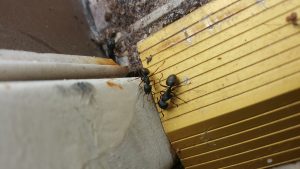
Pest Control Ant Removal extermination insecticide, pesticide, chemical and bug killer treatment products to spray, eliminate nests at fair prices of
http://ampmexterminators.com
Sugar Ants are the most common nuisance pest that we face in seattle. These ants do not do any damage to a home, but they sure can be annoying to have to deal with and they can be extremely tricky to get rid of as well. Although they are commonly referred to as “sugar ants”, they are actually a type of a soil ant called an “odorous house ant”. If you are wondering how they get that name, you can squish one with your finger to find out. They give off a distinct smell kind of like gasoline or rotting coconut that is unmistakable
An ant infestation can drive almost anyone crazy, trying to clean up the problem, only to find they’re back a few hours later can cause frustration to just about anyone.
Schedule an Ant Extermination Estimate
it to live in. If they are in parts of a building that are not
visible or little used they can cause extensive damage before
they are detected. An important thing to remember about
carpenter ants is that their colonies grow slowly and their
damage is done slowly.
Benefits of carpenter ants
Ants are a natural predator of other insects that are pests to
humans, especially termites. Carpenter ants are also
important in the landscape for their role in the breakdown
of wood debris and the creation of soil. They should be left
alone if they are in a location where they are not bothering
humans.
Carpenter ant food
Carpenter ants’ primary foods are other insects, the
honeydew produced by aphids and other insects, and plant
juices. They do not eat wood - they build nests in it. They
will forage for food such as meat, grease and sweets inside
the building. Worker ants share their food with other
colony members.
Removing food sources will help reduce, but may not
eliminate, a carpenter ant infestation. The queen and a few
workers will resort to cannibalism if necessary for their
survival.
Preferred nest locations
Carpenter ants prefer to tunnel into moist wood that is
infested with fungus, but they will also inhabit dry wood.
The main colony is usually outdoors and contains the
queen, workers and immatures. Satellite colonies are often
in buildings and contain workers, reproductives, older
larvae and pupae.
In buildings they live in one or more nests, which are a
combination of the tunnels they have excavated in either
hardwood or softwood. Usually they prefer structural wood and the spaces between boards, but they may be behind
shelves or in stored furniture. Other materials they may
infest are foam and fiberglass insulation. It is easier to
detect carpenter ants than termites within a building
because they will come out into the open while foraging and
can be caught in sticky traps. It can be very difficult to
locate their nests since they may be in areas that are
physically difficult to inspect.
In the landscape they are most likely to be living in a
dead tree or stump or in rotting wood in a living tree. If the
school property does not have nests, the ants may be coming
from a neighbor’s landscape, firewood pile or other wood
debris. An established colony may be spread out in satellite
colony nests located in several stumps or trees connected by
trails.
The carpenter ant life cycle
Ants go through four life stages over a two month period;
egg, larvae, pupae and then adults, which includes female
workers and soldiers, and one fertilized queen who
produces all the eggs. New reproductive queens and males
are produced at the end of the summer and spend the winter
in the nest. In the spring, the new reproductives swarm or
leave the main nest to start their own colonies. The male
dies after mating with the queen. The new queen finds a
nest site and starts a new colony. The spring swarming
period is when carpenter ants are most likely to be seen
around the school. A queen can live for many years and will
not produce new reproductives for 6 to 10 years.
How carpenter ants get into schools
Ants in the building are usually coming from nests outside.
A new colony may get started in the soil under decorative
landscaping bark or debris, but it will soon move into wood
through openings near the foundation.
Foraging ants follow trails from the nest to their
entryways into the building and back to the nest again.
These trails are kept clear of vegetation and are more
defined closer to the nest. Ants returning to the nest will be
carrying insect parts and food while ants leaving will not be
carrying anything. The trails will fan out and disappear as
they get further away from the nest.
No comments:
Post a Comment